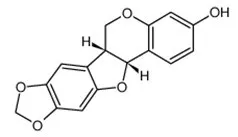| In vitro: |
| Experientia. 1986 May 15;42(5):568-70. | | The effect of the phytoalexins, lubimin, (-)-maackiain, pinosylvin, and the related compounds dehydroloroglossol and hordatine M on human lymphoblastoid cell lines.[Pubmed: 3709764] |
METHODS AND RESULTS:
We have tested the effect of the phytoalexins lubimin, (-)-Maackiain and pinosylvin and the related compounds dehydroloroglossol and hordatine M on the growth of the human lymphoblastoid cell lines Molt and Raji. (-)-Maackiain, pinosylvin and dehydroloroglossol showed significant growth inhibitory action on the cells. Suppression of [3H] thymidine and [3H] leucine uptake was tested and noted in pinosylvin and dehydroloroglossol.
CONCLUSIONS:
The phytoalexins and related compounds are widespread in plants and provide a potential source of antineoplastic substances. |
|
| In vivo: |
| Xenobiotica. 2015 Jun 11:1-13. | | Pharmacokinetic properties of trifolirhizin, (-)-maackiain, (-)-sophoranone and 2-(2,4-dihydroxyphenyl)-5,6-methylenedioxybenzofuran after intravenous and oral administration of Sophora tonkinensis extract in rats.[Pubmed: 26068519] | 1. SKI3301, a standardized dried 50% ethanolic extracts of Sophora tonkinensis, contains four marker compounds (trifolirhizin, TF; (-)-Maackiain, Maack; (-)-sophoranone, SPN, and (2-(2,4-dihydroxyphenyl)-5,6-methylenedioxybenzofuran, ABF), is being developed as an herbal medicine for the treatment of asthma in Korea.
METHODS AND RESULTS:
This study investigates the pharmacokinetic properties of SKI3301 extract in rats. 2. The dose-proportional AUCs suggest linear pharmacokinetics of TF, Maack, SPN and ABF in the SKI3301 extract intravenous dose range of 5-20 mg/kg. After the oral administration of 200-1000 mg/kg of the extract, TF and Maack exhibited non-linearity due to the saturation of gastrointestinal absorption. However, linear pharmacokinetics of SPN and ABF were observed. 3. The absorptions of TF, Maack, SPN and ABF in the extract were increased relative to those of the respective pure forms due to the increased solubility and/or the decreased metabolism by other components in the SKI3301 extract. 4. No accumulation was observed after multiple dosing, and the steady-state pharmacokinetics of TF, Maack, SPN and ABF were not significantly different from those after a single oral administration of the extract. 5. The pharmacokinetics of TF, SPN and ABF were not significantly different between male and female rats after oral administration of the extract, but a significant gender difference in the pharmacokinetics of Maack in rats was observed.
CONCLUSIONS:
6. Our findings may help to comprehensively elucidate the pharmacokinetic characteristics of TF, Maack, SPN and ABF and provide useful information for the clinical application of SKI3301 extract. |
|






 Cell. 2018 Jan 11;172(1-2):249-261.e12. doi: 10.1016/j.cell.2017.12.019.IF=36.216(2019)
Cell. 2018 Jan 11;172(1-2):249-261.e12. doi: 10.1016/j.cell.2017.12.019.IF=36.216(2019) Cell Metab. 2020 Mar 3;31(3):534-548.e5. doi: 10.1016/j.cmet.2020.01.002.IF=22.415(2019)
Cell Metab. 2020 Mar 3;31(3):534-548.e5. doi: 10.1016/j.cmet.2020.01.002.IF=22.415(2019) Mol Cell. 2017 Nov 16;68(4):673-685.e6. doi: 10.1016/j.molcel.2017.10.022.IF=14.548(2019)
Mol Cell. 2017 Nov 16;68(4):673-685.e6. doi: 10.1016/j.molcel.2017.10.022.IF=14.548(2019)